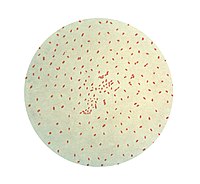
Photo from wikipedia
OBJECTIVE Introduction: The level of childhood bacterial diseases incidence does not have a downward trend. The aim: Conduction of a sociological analysis of medical cards for children with pertussis, meningococcal… Click to show full abstract
OBJECTIVE Introduction: The level of childhood bacterial diseases incidence does not have a downward trend. The aim: Conduction of a sociological analysis of medical cards for children with pertussis, meningococcal infection (MI), scarlet fever, and evaluation of consumed pharmacotherapy according to real clinical practice in Ukraine. PATIENTS AND METHODS Materials and methods: 1215 medical cards of inpatients; methods: sociological - document analysis, retrospective frequency. RESULTS Results: Among the cards of children with pertussis: 50.2% - female, 49.8%- male; by age children up to 1 year (49.3%) were prevailed. In 79.6% incidence - medium-hard form pertussis, 42.2% with complications. Among patients with MI by sex there were: 50.5 % - boys and 49.5% - girls; by age - children aged 1-4 (40.2%); the structure of generalized forms of MI: 40.2% - meningococcemia, 11.4% - meningitis, 48.4% - combination. Scarlet fever was more frequently: boys (56.4%), children aged 5-9 (44.7%), urban residents (79.7%); it was 93.4% of a medium-hard form. Most of medicines were prescribed to children with MI - 15.8 trade names per 1 person, it was prescribed 191 INN, most often - Sodium chloride (90.0%), Ascorbic acid (68.5%), Ceftriaxone (65.8%); patients with pertussis - 11.2, 196 INN (Chlorpromazine (69.1%), Dexamethasone (53.2%), Butamirate (51.8%)); scarlet fever - 9.3 medicines, 114 INN (local action Comb drug for throat diseases treatment (94.4%), Ceftriaxone (48.7%), Metamizole sodium (38.1%)). CONCLUSION Conclusions: Frequency analysis data of consumed pharmacotherapy in real pediatric practice in Ukraine shows the need for its further optimization in accordance with the principles of evidence-based medicine, the results of research on the socio-demographic characteristics of patients, forms and complications of course of the basic disease.
Journal Title: Wiadomosci lekarskie
Year Published: 2019
Link to full text (if available)
Share on Social Media: Sign Up to like & get
recommendations!